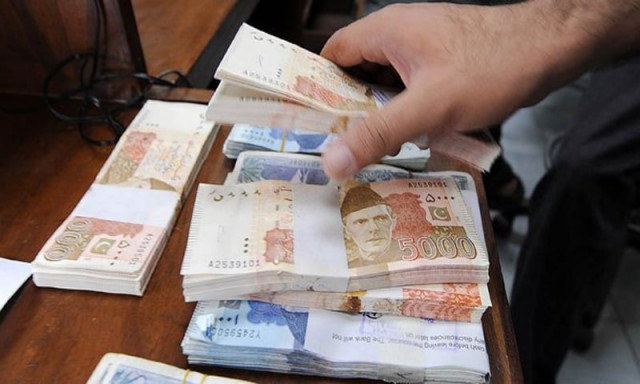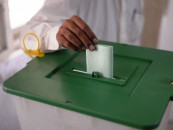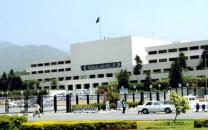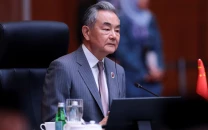Economic growth target set at 4.8%
Inflation estimated to remain at 8% in next fiscal year

The federal government on Friday approved an economic growth target of 4.8% and estimated inflation to remain at 8% for its fourth year in power amid a vast variation in current account deficit projections given by the finance ministry and the planning commission for the next fiscal year.
“The Annual Plan Coordination Committee [APCC] has approved a 4.8% economic growth rate target for the fiscal year 2021-22,” Planning and Development Minister Asad Umar said at a news conference after the body's meeting.
The 4.8% growth target is marginally less than the one suggested by the finance ministry in a parliamentary committee meeting.
The APCC also set the inflation target at 8% for the next fiscal year. However, its approved inflation target of 6.5% for the current fiscal year has been missed by a wide margin.
The economic plan will now be tabled before the National Economic Council (NEC) on June 4 for its formal endorsement. The NEC meeting will be headed by Prime Minister Imran Khan.
The NEC is a constitutional body responsible for macroeconomic planning and the deputy chairman of the planning commission heads the APCC.
Umar said the highlight of the outgoing fiscal year was that the gross national product (GNP) increased to a 16-year high and grew by 6.5% due to strong growth in foreign remittances. The foreign remittances are not included in the gross domestic product (GDP).
However, the GNP estimates are also based on an assumption that in addition to formal remittances transferred through banks, about 14% or Rs656 billion was transferred by international travellers by bypassing these channels.
As international travel has been largely restricted this year due to the Covid-19 pandemic, the 14% assumption appears on the high side – in turn inflating the GNP growth figure of 6.5%.
One of the reasons behind significant increase in foreign remittances in this fiscal year was closure or restrictions on air travel.
The minister said foreign remittances were expected to peak to $29.3 billion in this fiscal year. They have been estimated to increase to $31.3 billion in the next fiscal year.
Umar said the agricultural sector was expected to grow by 3.4% in the next fiscal year as against 2.8% in the ongoing one.
The services sector is projected to grow by 4.7% as against this year’s estimates of 4.4%. The Industrial sector growth target is 6.8% compared to this year’s growth estimate of 3.6%.
“Cotton production that dipped to seven million bales this year is expected jack up to 10.6 million in 2021-22 on the back of good quality supplies of seeds and pesticides,” said Umar.
The manufacturing sector growth target is 6.2% and large-scale manufacturing 6% -- both lower than this year’s growth estimates. The electricity generation is targeted to grow by 6% next year.
National savings are projected to increase to 14.2% as against 13.9% of the GDP this year.
The total investment is also projected to increase to 16% of the GDP as against 15.2% this year. National savings have been projected to remain unchanged at 15.3% of the GDP in the next fiscal year too.
The minister said the APCC had approved the current account deficit target at 0.7% of the GDP or $2.3 billion.
“There will be minor current account surplus of $200 million this fiscal year,” he added.
However, the finance ministry has projected $4.8 billion worth of the current account deficit in the next fiscal year, which is equal to 1.4% of the GDP.
“The APCC is the right forum for approving these targets. It has approved $2.3 billion for the next fiscal year with the backing of all stakeholders,” the minister said responding to a question.
Umar said the higher current account projections could be because the finance ministry had projected over 5% GDP growth target for the next fiscal year.
“The more you grow, the higher will be the current account deficit.”
Umar said the country could afford to have up to 2% of the GDP current account deficit and the PTI government had tried to follow an economic model of sustainable growth by relying on productive sectors of the economy.
“If we tried to achieve growth by adopting methods used by the PML-N like exploding the current account and budget deficits, we would not have a place to hide in the upcoming elections,” he added.
The government has approved exports target at $26.8 billion -- higher by only $1.6 billion or 6.3% against this year’s estimated exports.
The imports target is $55.3 billion -- up by $4.9 billon or 9.7%.
The trade deficit is projected to widen to $28.4 billion in the next fiscal year -- up by $3.2 billion or 12.7%.



















COMMENTS
Comments are moderated and generally will be posted if they are on-topic and not abusive.
For more information, please see our Comments FAQ